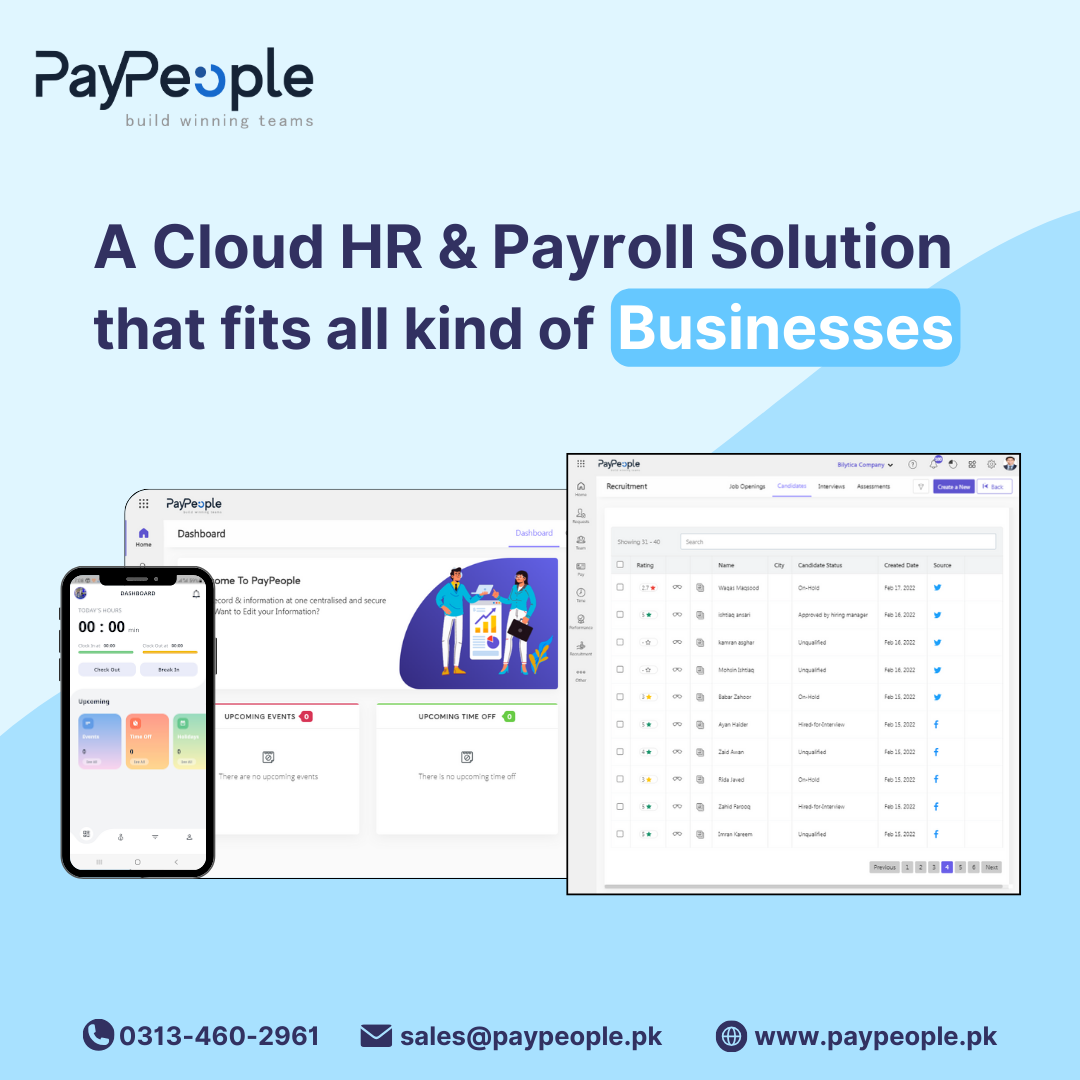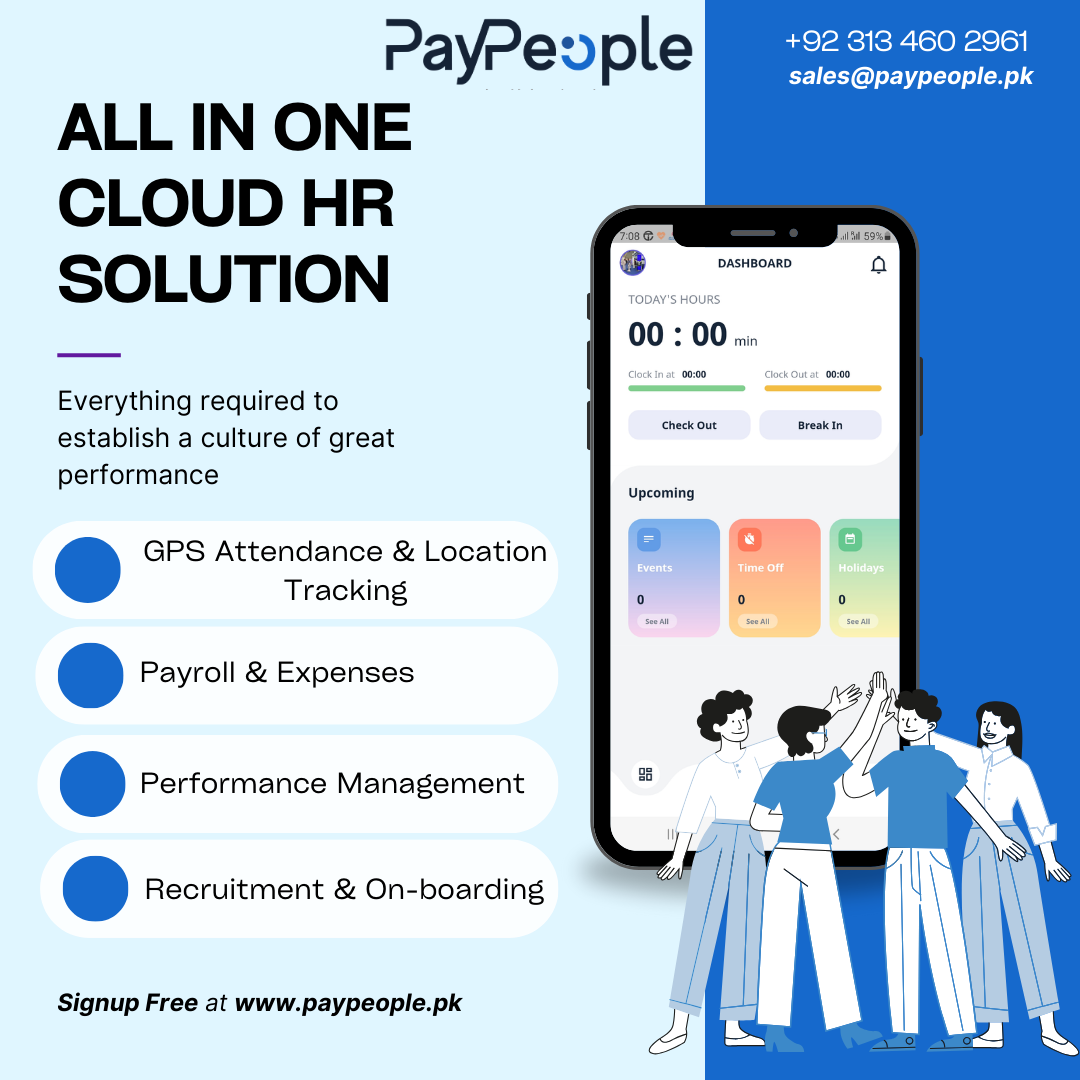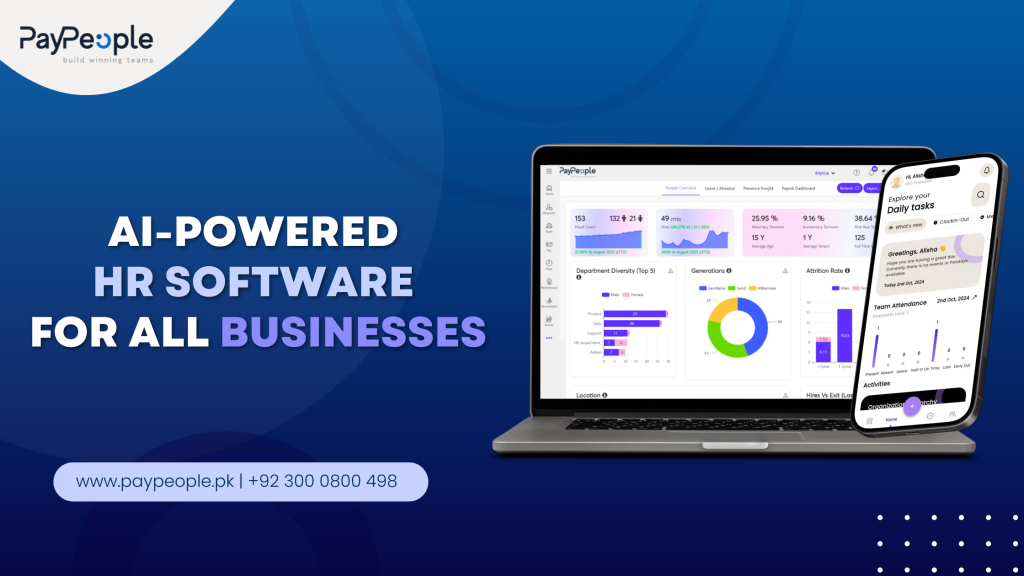Paypeople # 1 is one of the top HR Software in Pakistan any organization is a significant investment, and understanding the cost implications is crucial for making informed decisions. In Pakistan, where businesses range from small enterprises to large corporations, the adoption of HR software is becoming increasingly common. However, the cost implications vary based on several factors, including the size of the organization, the complexity of its HR processes, the features required, and the type of software chosen. This article explores the cost implications of implementing HR software in Pakistan, examining both direct and indirect costs, as well as the potential return on investment (ROI).
Click to Start Whatsapp Chat with Sales
Call #:+923000507555
Email: sales@Paypeople.pk
Paypeople # 1 HR Software in Pakistan

Direct Costs
Licensing Fees: The most immediate cost associated with HR Software in Pakistan is the licensing fee. This can vary significantly depending on whether the organization opts for on-premise software or a cloud-based solution. On-premise solutions typically involve a higher upfront cost for purchasing the software license, whereas cloud-based solutions often operate on a subscription model with monthly or annual fees. In Pakistan, the choice between these models can depend on factors such as budget constraints, the need for scalability, and the organization’s infrastructure.
Implementation and Customization Costs: The implementation phase of HR software can also incur significant costs. This includes expenses related to setting up the software, migrating data from existing systems, and integrating with other business applications. Customization costs are also a consideration, as businesses often require the software to be tailored to their specific needs. Customization may involve modifying existing features or developing new modules, which can add to the overall cost.
Hardware and Infrastructure Costs: For on-premise HR software solutions, organizations need to invest in the necessary hardware and infrastructure. This includes servers, storage devices, and network equipment. Additionally, there may be costs associated with maintaining and upgrading this hardware over time. In contrast, cloud-based solutions typically reduce these costs as they are hosted off-site, with the provider managing the infrastructure.
Training Costs: Implementing new HR software often requires training for HR staff and other users. Training costs can include hiring trainers, developing training materials, and the time spent by employees in training sessions. Effective training is crucial to ensure that the staff can fully utilize the features of the HR software, which can improve efficiency and reduce errors.
Support and Maintenance Costs: Ongoing support and maintenance are essential to ensure the smooth operation of HR software. This can include technical support, software updates, and bug fixes. Some providers offer these services as part of the subscription fee, while others may charge extra. In the case of on-premise solutions, organizations may need to employ in-house IT staff or contract with external service providers for support and maintenance.
Indirect Costs
Opportunity Costs: Opportunity costs refer to the potential benefits that an organization forgoes by choosing one option over another. In the context of HR software, this could mean lost productivity during the transition period as employees learn the new system. There may also be a temporary decline in efficiency as processes are adapted to the new software, which could impact overall business performance.
Change Management Costs: Implementing HR software often involves significant changes to existing workflows and processes. The cost of managing these changes, which includes communication, training, and support, can be substantial. Change management is critical to the successful adoption of new software, as it helps employees understand and embrace the new system, reducing resistance and improving the likelihood of a smooth transition.
Data Migration Costs: Migrating data from legacy systems to new HR Software in Pakistan can be a complex and costly process. This involves not only transferring data but also ensuring its accuracy, consistency, and integrity. Inaccurate or incomplete data migration can lead to significant issues down the line, affecting payroll, benefits administration, and compliance.
Compliance Costs: HR software must comply with local labor laws and regulations, which can vary widely. Ensuring that the software is configured to meet these requirements may involve additional costs, particularly if the organization operates in multiple regions or countries. Non-compliance can result in legal penalties, making it essential to account for these costs in the overall budget.

Potential Return on Investment (ROI)
Increased Efficiency and Productivity: One of the primary benefits of Recruitment software in Pakistan is the automation of time-consuming HR processes, such as payroll, attendance tracking, and benefits administration. This automation can lead to significant time savings for HR staff, allowing them to focus on more strategic activities. Improved efficiency and productivity can translate into cost savings and a better allocation of resources.
Improved Accuracy and Compliance: HR software helps reduce errors in critical areas such as payroll processing and tax calculations. By automating these processes, organizations can minimize the risk of costly mistakes and ensure compliance with local labor laws and tax regulations. This not only reduces the likelihood of fines and penalties but also enhances the organization’s reputation and employee satisfaction.
Enhanced Data Security: HR software often includes advanced security features, such as data encryption, access controls, and regular backups. These features protect sensitive employee data from unauthorized access and data breaches, which can have significant financial and reputational consequences. Investing in HR software with robust security measures can therefore mitigate the risk of data-related incidents.
Better Decision-Making: HR software provides powerful analytics and reporting tools that enable organizations to make data-driven decisions. By analyzing trends in areas such as employee performance, turnover, and recruitment, businesses can identify opportunities for improvement and optimize their HR strategies. This can lead to better workforce planning, improved employee engagement, and a more competitive position in the market.
Scalability and Flexibility: Many HR software solutions offer scalable and flexible options, allowing businesses to adjust the software as they grow. This scalability is particularly beneficial for small and medium-sized enterprises (SMEs) in Pakistan, which may need to expand their HR capabilities as they increase their workforce. The ability to scale the software without significant additional costs ensures that the organization can continue to meet its HR needs over time.
Cost-Benefit Analysis
Assessing the Total Cost of Ownership (TCO): To determine the cost-effectiveness of HR software, organizations should conduct a total cost of ownership (TCO) analysis. This involves calculating all direct and indirect costs associated with the software, including licensing, implementation, training, and maintenance. Comparing the TCO with the expected benefits, such as cost savings and productivity gains, can help organizations assess the overall value of the investment.
Evaluating the Long-Term Benefits: While the initial costs of implementing HR software can be high, the long-term benefits often outweigh these expenses. By improving efficiency, accuracy, and compliance, HR software can generate significant savings and enhance the organization’s overall performance. Additionally, the ability to access and analyze HR data can provide valuable insights that support strategic decision-making and business growth.
Making Informed Decisions: When considering the implementation of HRMS in Pakistan, organizations in Pakistan should carefully evaluate their needs and budget. It’s essential to choose a solution that aligns with the organization’s size, industry, and HR requirements. Consulting with HR and IT experts can also help in selecting the right software and planning for the associated costs.
Conclusion
The cost implications of implementing HR software in Pakistan are multifaceted, encompassing both direct and indirect expenses. While the initial investment can be substantial, the benefits of increased efficiency, improved accuracy, and better compliance often justify the cost. By conducting a thorough cost-benefit analysis and carefully planning the implementation process, organizations can maximize the return on their investment in HR software. As businesses in Pakistan continue to grow and evolve, the adoption of advanced HR technologies will be critical to maintaining a competitive edge and supporting long-term success.
Click to Start Whatsapp Chat with Sales
Call #:+923000507555
Email: sales@Paypeople.pk
HR Software in Pakistan
HR Software in Pakistan
HR Software in Pakistan
We are one of the best Cost implications of implementing HR Software in Pakistan Price in Pakistan in Azad Kashmir, Bagh, Bhimber, khuiratta, Kotli, Mangla, Mirpur, Muzaffarabad, Plandri, Rawalakot, Punch, Balochistan, Amir Chah, Bazdar, Bela, Bellpat, Bagh, Burj, Chagai, Chah Sandan, Chakku, Chaman, Chhatr, updated on 2025-07-19T07:11:02+05:00 Dalbandin, Dera BugtiBarcode Shop offer lowest Cost implications of implementing HR Software in Pakistan Price Face Recognition in cities Dhana Sar, Diwana, Duki, Dushi, Duzab, Gajar, Gandava, Garhi Khairo, Garruck, Ghazluna, Girdan, Gulistan, Gwadar, Gwash, Hab Chauki, Hameedabad, Harnai, Hinglaj, Hoshab, Ispikan, Jhal, Jhal Jhao, Jhatpat, Jiwani, Kalandi, Kalat, Kamararod, Kanak, Kandi, Kanpur, Kapip, KapparWe can deliver Face Recognition in Karodi, Katuri, Kharan, Khuzdar, Kikki, updated on 2025-07-19T07:11:02+05:00 Kohan, Kohlu, Korak, Lahri, Lasbela, Liari, Loralai, Mach, Mand, Manguchar, Mashki Chah, Maslti, Mastung, Mekhtar, Merui, Mianez, Murgha Kibzai, Musa Khel Bazar, Nagha Kalat, Nal, Naseerabad, Nauroz Kalat, Nur Gamma, Nushki, Nuttal, Ormara, Palantuk, Panjgur, Pasni, Piharak, Pishin, Qamruddin Karez, Qila Abdullah, Qila Ladgasht and this was updated on 2025-07-19T07:11:02+05:00 We also deal with Cost implications of implementing HR Software in Pakistan Price in Qila Safed, Qila Saifullah, Quetta, Rakhni, Robat Thana, Rodkhan, Saindak, Sanjawi, Saruna, Shabaz Kalat, Shahpur, Sharam Jogizai, Shingar, Shorap, Sibi, Sonmiani, Spezand, Spintangi, Sui, Suntsar, Surab, Thalo, Tump, Turbat, Umarao, pirMahal, Uthal, Vitakri, Wadh, Washap, Wasjuk, Yakmach, Zhob, Federally Administered Northern Areas/FANAWe are already sent Face Recognition to these places – Astor, updated on 2025-07-19T07:11:02+05:00 Baramula, Hunza, Gilgit, Nagar, Skardu, Shangrila, Shandur, Federally Administered Tribal Areas/FATA, Bajaur, Hangu, Malakand, Miram Shah, Mohmand, Khyber, Kurram, North Waziristan, South Waziristan, Wana, NWFP, Abbottabad, Ayubia, Adezai, Banda Daud Shah, Bannu, Batagram, Birote, Buner, Chakdara, Charsadda, Chitral, Dargai, Darya Khan, Dera Ismail Khan and this was updated on 2025-07-19T07:11:02+05:00 we are planning to open a branch office of in Drasan, Drosh, Hangu, Haripur, Kalam, Karak, Khanaspur, Kohat, Kohistan, Lakki Marwat, Latamber, Lower Dir, Madyan, Malakand, Mansehra, Mardan, updated on 2025-07-19T07:11:02+05:00 Mastuj, Mongora, Nowshera, Paharpur, Peshawar, Saidu Sharif, Shangla, Sakesar, Swabi, Swat, Tangi, Tank, Thall, Tordher, Upper Dir, Punjab, Ahmedpur East, Ahmed Nager Chatha, Ali Pur, Arifwala, Attock, Basti Malook, BhagalchurFace Recognition in Bhalwal, Bahawalnagar, Bahawalpur, Bhaipheru, Bhakkar, Burewala, Chailianwala, Chakwal, Chichawatni, Chiniot, Chowk Azam, Chowk Sarwar Shaheed, Daska, Darya Khan, Dera Ghazi Khan, Derawar Fort, updated on 2025-07-19T07:11:02+05:00 Dhaular, Dina City, Dinga, Dipalpur, Faisalabad, Fateh Jang, Gadar, Ghakhar MandiFace Recognition Cost implications of implementing HR Software in Pakistan Price s Demands very high in Gujranwala, Gujrat, Gujar Khan, Hafizabad, Haroonabad, Hasilpur, Haveli Lakha, Jampur, Jhang, Jhelum, Kalabagh, Karor Lal Esan, Kasur, Kamalia, Kamokey, Khanewal, Khanpur, Kharian, Khushab, Kot Addu, Jahania, Jalla Araain, Jauharabad, Laar, Lahore, Lalamusa, Layyah, Lodhran, Mamoori, Mandi Bahauddin, Makhdoom Aali, Mandi Warburton, Mailsi, Mian Channu, Minawala, Mianwali, Multan, Murree, Muridke, Muzaffargarh, Narowal, Okara, Renala Khurd, Rajan Pur, Pak Pattan, Panjgur and this was updated on 2025-07-19T07:11:02+05:00 and current Cost implications of implementing HR Software in Pakistan Price of is Rs 100 in Pattoki, Pirmahal, Qila Didar Singh, Rabwah, Raiwind, Rajan Pur, Rahim Yar Khan, Rawalpindi, Rohri, Sadiqabad, Safdar Abad – (Dhaban Singh), Sahiwal, Sangla Hill, Samberial, Sarai Alamgir, Sargodha, Shakargarh, Shafqat Shaheed Chowk, Sheikhupura, Sialkot, Sohawa, Sooianwala, Sundar (city), Talagang, Tarbela, Takhtbai, Taxila, Toba Tek Singh, Vehari, Wah Cantonment, Wazirabad and this was updated on 2025-07-19T07:11:02+05:00 Software solutions are widely available with Price updated on 2025-07-19T07:11:02+05:00 in Sindh, Ali Bandar, Baden, Chachro, Dadu, Digri, Diplo, Dokri, Gadra, Ghanian, Ghauspur, Ghotki, Hala, Hyderabad, Islamkot, Jacobabad, Jamesabad, Jamshoro, Janghar, Jati (Mughalbhin), Jhudo, Jungshahi, Kandiaro, Lahore, Kashmor, Keti Bandar, Khairpur, updated on 2025-07-19T07:11:02+05:00 Khora, Klupro, Khokhropur, Korangi, Kotri, Kot Sarae, Larkana, Lund, Mathi, Matiari, Mehar, Mirpur Batoro, Mirpur Khas, Mirpur Sakro, updated on 2025-07-19T07:11:02+05:00 Mithi, MithaniThe Barcode Shop deliver high quality Face Recognition in updated on 2025-07-19T07:11:02+05:00 Moro, Nagar Parkar, Naushara, Naudero, Noushero Feroz, Nawabshah, Nazimabad, Naokot, Pendoo, Pokran, Qambar, Qazi Ahmad, Ranipur, Ratodero, Rohri, Saidu Sharif, Sakrand, Sanghar, Shadadkhot, Shahbandar, Shahdadpur, Shahpur Chakar, Shikarpur, Sujawal, Sukkur, Tando Adam, Tando Allahyar, Tando Bago, Tar Ahamd Rind, Thatta, Tujal, Umarkot, Veirwaro, Warah and this was updated on 2025-07-19T07:11:02+05:00
7-30-2024


